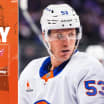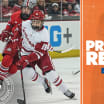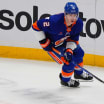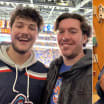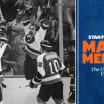The great debate began during the Summer of 1992.
Is the future now? Yes or no -- will the Islanders have a playoff team?
Bill Torrey thought so, but as general manager he was about as objective as the four Stanley Cup banners hanging from the Nassau Veterans Memorial Coliseum rafters.
Maven's Memories: 1992-93 A Season to Remember
New faces on the blue line and a 50-goal season from Pierre Turgeon highlighted the 1992-93 regular season

© B Bennett/Getty Images
By
Stan Fischler
Special to NHL.com
"We aren't fooling around," Bow Tie Bill argued. "No question, we came close last March (1992) and might have made it except for all the injuries. That said, we've done some big work in the offseason."
It began with the June Entry Draft. Torrey began taking chances he had avoided in the past. For one thing he had not yet signed players from certain European countries. Now he began lifting the curtain; iron and silk.
Bill's overseas birddogs had been sending him communiques from distant Lithuania about a defenseman who was light years ahead of his contemporaries. Frankly, this firebrand was too good to be true.
Darius Kasparaitis.
"When he was 16," one scouting report noted, "the kid was the first Lithuanian asked to play for a Soviet league team. That's how good he is."
As rave piled on rave, Bow Tie Bill went for the bait and consummated a deal with the Maple Leafs. He dealt his eighth-overall pick from the first round plus a second rounder in return for Toronto's fifth pick overall.
With the Number Five selection, he was able to snare a defenseman who had more than a dozen NHL managers drooling for a chance to make the grab.
Torrey: "We paid a steep price but we know it's worth it. Darius blasts all convention about Europeans to hell. He has a fire that can be infectious."
Before even donning an Islanders jersey, Kasparaitus already was wearing a Gold Medal he had won on the title Russian team in the World Championships.

© B Bennett/Getty Images
ALUMNI CORNER: DARIUS KASPARAITIS
As luck would have it, Steve Thomas played in the WC. Thomas waxed ecstatic about a big Russian whose size and style reminded him of Montreal Canadiens icon blue liner, Larry Robinson.
That Russian, Vladimir Malakhov.
"I got lucky with him," said Torrey. "We got Vlad in the 10th round in 1989. Now he was ready for the big-time. By the time I signed him he already had been captain of the Central Red Army Team."
While all this was going on the Isles new management-ownership group of Steve Walsh, Robert Rosenthal, Ralph Palleschi and Paul Greenwood was formally introduced on August 17, 1992. Their theme: "The New Ice Age."
Nice slogan; no problem with that as long as the team produces. Meanwhile, a chain reaction of behind-the-scenes shockers exploded like July Fourth fireworks, flaring in several directions.
For those who followed the franchise for two decades the biggest blast involved the high command. The Architect, Bill Torrey, was replaced by Don Maloney who recently had been Bow Tie Bill's recent right hand man.
As for Blast Two, Bryan Trottier disputed the "You Can't Go Home Again" theory by returning from Pittsburgh to become executive assistant to the president. This, after Trots won a pair of Stanley Cups with the Penguins.
Meanwhile, Maloney wasted no time beefing up the brass by importing Darcy Regier as assistant general manager. (Regier previously had been an assistant coach in Hartford.)
The one move not made was the best, as Arbour retained his head coaching role. Checking his lineup before opening training camp, 1992, the respected mentor of mentors couldn't help but stifle a confident grin.
"I like our balance," Al observed. "With this roster, we have a very good shot at the playoffs."
Well, Radar could have added a few "ifs." As long as Glenn Healy stayed healthy, goaltending was in good hands -- and mouth, since Heals was the Master Quipper of the team. But the quality of his defense remained a puzzle.
Nobody could say for sure how well the imports, Darius Kasparaitis and Vlad Malakhov, would adjust to NHL play nor whether high draft pick, Scott Lachance, would blend into the Nassau blue line corps in his first full season.
The offense wouldn't necessarily carry the team to the Stanley Cup Final round but it had considerable promise. After all Pierre Turgeon had superstar written all over him. For the classy French-Canadian, the sky was the limit.
Neither of Lucky Pierre's linemates, Steve Thomas nor Derek King could be accused of being a slouch. Ditto for Ray Ferraro, fast becoming Bow Tie Bill's find of the decade.
Redoubtable Ray's partners -- Benny Hogue and Patrick Flatley -- knew the score. "They 'get it'," said Ferraro. "We're gonna have some fun."
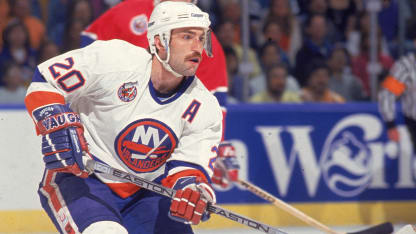
© J Giamundo/Getty Images
ALUMNI CORNER: RAY FERRARO
So would the reserves who would provide better depth than Radar had in years. Claude Loiselle and Tom Fitzgerald would become an A-1 PK combo while Marty McInnis, Brad Dalgarno, Mick Vukota and Brian Muller were qualified swing-men.
Finally, when not driving the Skipper nuts with his enigmatic idiosyncrasies, David Volek always could be useful -- provided that the spirit moved him. When that happened you could see "Halleluyah" written all over Al's face.
Of course it didn't happen right away. For starters, the club only enjoyed 14 home games out its first 38 contests and for finishers a five-game autumn losing streak compelled captain Flatley to demonstrate his leadership.
In mid-November Flats had had enough of losing and announced a no-kidding-around "Players Only" meeting. Behind closed doors it was agreed to stop the nonsense and start winning.
Flatley: "We made a few pacts with each other. Things we were going to stop doing and things we are planning to start doing to get back into the race."
The front office got into the act, demoting McInnis and Tom Kurvers to Capital District in the American League while recalling Travis Green. Maloney would have no "Teacher's Pets" and told his guys, eyes-to-eyes a few choice things.
"Let's not look outside this dressing room for help," the new GM demanded. "I'd like every player who's here now to stay here."
Whether it was Maloney's monologue or simply maturation, the Nassaumen began to fulfill their preseason notices; especially the three new defenders.
Although he barely reached six feet standing on his toes, Kasper put fear in the hearts of the largest enemy skaters. His "Snake Hip" checks had the disturbing effect of a U-Boat torpedo slamming into an enemy cruiser amidships.
"Kasper is a throw-back," said Tampa Bay broadcaster Larry Hirsch. "He reminds me of the old-time open-ice hitters from pre-war days. Once he lines a guy up, he rarely misses; and he hurts!"
Rangers tv analyst John Davidson called some of Dangerous Darius' moves, "Just plain scary."
During a home and home series with New Jersey, Kasper nearly hospitalized Devils forwards Kevin Todd and Randy McKay with well-synchronized, perfectly legitimate hits.
Naturally there were anti-Kasparaitis dissenters -- Davidson -- who questioned the legitimacy of the Darius devastation. It got to a point where in far-away Lithuania, even the rookie's mother was worried.
"I had to phone her," Darius explained, "because somebody told my mother that it was in the papers that the Devils wanted to kill me." (He remained unhurt and Momma K was happy again.)
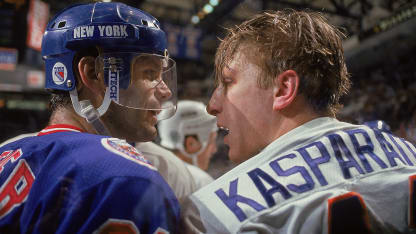
© B Bennett/Getty Images
Meanwhile, the less ostentatious defense partner, Malakhov, wasn't doing too badly himself. Vlad's experience in world tourneys carried over to the NHL, especially on Radar's power play. Even Lachance surprised.
"We weren't too sure at camp about Scotty," said Arbour. "I mean whether he could step right in and be effective. But he adjusted well -- with a lot of help from his partner (Uwe) Krupp."
By far, the most help up front was provided by Turgeon. No forward in franchise history ever accomplished more in a lower key than the graceful stylist from Rouyn, Quebec.
In his Who's Who of Hockey, "Players," historian Andrew Podnieks lauded Turgeon's emergence to the NHL's center stage as an Islander and beyond.
"Pierre was on his way to recording Hall of Fame numbers," wrote Podnieks. "In the end, he played more than a thousand games and recorded more than a thousand points."
In other words Pierre played like a first-overall draft pick that he had been in 1987.
A good five years later he was reaching his prime as a player in Uniondale. Yet his will 'o the wisp, unobtrusive style left him with less media attention than his excellence deserved. Except that is, among his mates who knew him best.
"Pierre is different from most superstars," asserted Stevie Thomas. "He doesn't know how good he is. So, whenever I have the chance, I have to remind him."
From time to time Radar had to be reminded about the brainstorm that he enjoyed one day that led him to construct a "Kid Line" with dipsy-doodling Travis Green centering the returned Marty McInnis and Brad Dalgarno.
"Al was the one who taught me how to be a big-leaguer," Green admitted. "From the time he put our line together we began to jell."
Arbour sensed that the round blocks were fitting into the round holes and the square ones likewise with the square holes. By mid-season a sense of enthusiasm returned to the Coliseum
"We're developing a winning habit," the head coach enthused. "We now have the desire to do whatever it takes to win. The guys are seeing the benefits of their hard work and their smart work."
The challenge was there for all hands in the Coliseum dressing room. It was a matter of conquering the second half of the schedule and once and for all annexing a playoff berth.
"Everyone was believing," said captain Flatley, "that it could happen!"
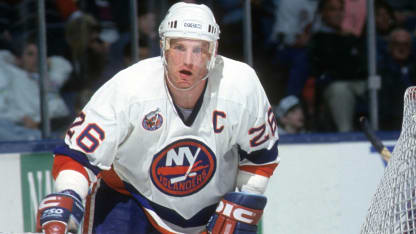
© B Bennett/Getty Images
MAVEN'S MEMORIES: PATRICK FLATLEY
In mid-January 1993, the Islanders were desperately looking for that elusive chemistry. If, somehow, they find it, they'll make the playoffs. Gradually, in that fateful month, the grand mix-master, Arbour found the ingredients.
When that happened, the Isles found themselves. "That good feeling was beginning to return," said Flatley.
The new ingredients added to the roster coalesced better than the captain or Professor Al could have imagined. Between the two they could have earned a PH.D in Hockey Chemistry.
Formula A was Benoit Hogue, acquired from Buffalo as a veritable throw-away by the Sabres. In Uniondale, Benny was re-invented as a marvelous offensive force.
"He's twice the player now that he was in Buffalo," said Uwe Krupp.
The National Hockey League gurus seconded the motion by voting the fleet French-Canadian "Player of the Week" at the end of January.
Some journalists on the Islanders beat went a step further and suggested that Benny's consistency had lifted him to second on the team in value, right behind Pierre Turgeon.
"Hogue's doing everything we him to do," said an enthused Arbour. "He's scoring, checking and is a beast as a penalty-killer."
Radar missed one thing: Benny was not too bad on a penalty shot either. On February 16, 1993, he beat the Oilers on his freebie while the Nassaumen crushed Edmonton, 7-2.
Meanwhile, Turgeon took command every which way and was rewarded by a spot on the NHL All-Star Team. Al's earlier experiment with the Travis Green-Marty McInnis-Brad Dalgarno unit blended famously. Ergo: Permanent Kid Line.
"They're an inspiration to us," lauded Hogue of Travis and his linemates.
Where in the early going of '92-'93, an injury -- Ray Ferraro's broken leg as an example -- would have led to a crisis; now such obstacles gleefully were regarded as challenges to be met and conquered.
Perhaps the keenest test of adversity occurred when superior goalie Glenn (I'm The Heals and Flats Star) Healy went down with tendonitis. Back-up Mark Fitzpatrick was summoned to douse any brushfires.
Over eight games, Fitz never was better, delivering a 5-2-1 mark and looking more confident than ever. Strong help was provided by grit guys, especially Loiselle who could drive opponents nuts in both French and English.
Flatley: "As long as he's on your team, you have to love Claude. He's one of the most annoying players in the league. And I mean that as a compliment."
MAVEN'S MEMORIES
WRITTEN COVERAGE
Making News in 1991-92
The Big Bang of 1991
The Tumultuous 1990-91 Season
Brent Sutter: Anonymous Star
Maven's Haven
Every day and in every way, the trades that dispatched Pat LaFontaine and Brent Sutter to foreign ice looked good. So were the Islanders chances of making the playoffs for the first time in two years.
Along the way, good things were happening including a most sentimental evening on February 20th. As the crowd cheered BILL-EE, BILL-EE, the banner bearing SMITH 31 was pulled to the Coliseum rafters.
One of the better -- if not the best -- clutch goaltenders in NHL history, Smith was toasted in an elegant and emotional ceremony.
Two-fisted Billy wasn't in the dressing room when it happened but a smile crossed his sometimes belligerent face when Smith was told what happened when Flatley addressed his men prior to the game with Pittsburgh.
"I tried before the game to say, 'Let's win it for Billy," Flats grinned. "But the guys wouldn't buy it. They said, 'The hell with him, let's win it for ourselves.'"
Turgeon, who was one of those Smith 'dissenters.' then took the ice and clipped the defending champion Penguins with a three-goal game leading to a 4-2 victory.
Even coach Arbour's "Doghouse" emptied when implacable David Volek was released after being deleted for 17 straight games. The fleet Czech responded with some of his best hockey as an Islander.
All of the above was essential because neither the Rangers, Capitals nor Devils were sitting on their hands. They were keeping pace with the Nassaumen in the quest for one of the final three Patrick Division playoff berths.
"By the end of February," asserted Uwe Krupp, "we found our swagger and got harder to beat."
In a five-game span, beginning on February 27 through March 9, the Arbour-men went 5-for-5. "What's more," said Ferraro, "we were skating like we belonged in the playoffs."
The first four wins were by the skin of a goal. In the last game of the quintet, against the play-off hungry Flyers, the Isles defenders blunted a -- goalie-removed -- 6-on-3 advantage to win the contest, 4-2.
Perhaps the most melodramatic game in the homestretch run took place at Madison Square Garden on April 2, 1993. The World's Most Famous Arena was jammed to the ceiling for this one; and everyone knew the reason why.
A Rangers victory would give them a good shot at the post-season, but if the visitors from Nassau won it would move the Isles closer to clinching a post-season berth while virtually eliminating the Blueshirts.
At the end of regulation time, the score was knotted at 2-2. This was an ideal occasion for a big-gamer to come through and that's precisely what happened. The Islanders go-to guy, Pierre Turgeon, lit the red light at 3:41 of overtime.
Not only was Lucky Pierre mobbed because of his dramatic tally but the extra added attraction happened to be his 50th goal of the season.
After The Island: Pierre Turgeon
ALUMNI CORNER: PIERRE TURGEON
Unfortunately, all "We're in the playoffs!" celebrations were put on hold when the very-lowly Ottawa Senators visited Uniondale and stunned the Locals with the Sens first road win of the season! (Ugh!!!)
Such nonsense had to be put to an end and it was 24-hours later in East Rutherford, New Jersey where the Isles regained their composure -- perhaps also their senses -- and topped the Devils, 5-4.
Ironically, the Rangers provided Arbour with his playoff clincher when the Blueshirts lost to the Flyers and, once again, all was well with the world on Long Island.
All that remained was learning which of Radar's foes his club would face -- either the defending champion Penguins or the Washington Capitals.
While waiting for the answer, Arbour put his team's 1992-93 season into perspective.
"I'm proud of our players," Radar concluded. "The last 30 games of the season were like playoff games for us. We won a lot of tough games."
But the toughest ones were just ahead!
LISTS: FOUR REASONS WHY THE ISLES MADE THE PLAYOFFS.
1. LUCKY PIERRE: Turgeon had been a very good player for the Buffalo Sabres. As an Islander, Pierre became a superstar.
2. GOALTENDING TANDEM: During the halcyon Dynasty Days, the winning duet was Bill Smith-Glenn Resch and later Smitty and Rollie Melanson. This time Glenn Healy and Mark Fitzpatrick made beautiful music together.
3. THE LUNCHPAIL FOUR:Claude Loiselle, Tom Fitzpatrick, Brad Dalgarno and Travis Green each found an extra gallon in their respective tanks when needed and that made a positive difference in the playoff march.
4. THE SPANKING NEW FERRARO: After returning from a serious injury, Rapid Ray scintillated as second line center behind Turgeon. Ray inspired the best out of Green and Dalgarno.






